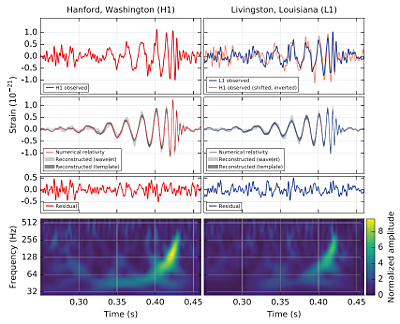
For the first time, scientists have observed ripples in the fabric of spacetime - gravitational waves - arriving at the earth from a cataclysmic event in the distant universe: collision and merger of two stellar-mass black holes and creation of a new, fastly-rotating black hole. This confirms a major prediction of Albert Einstein’s 1915 general theory of relativity, constitutes a direct observation of a black hole and a binary system of black holes, and opens an unprecedented new observational window onto the Universe.
The gravitational waves were detected on September 14, 2015 by the American project LIGO (Laser Interferometer Gravitational-wave Observatory) and European project Virgo, who in the LIGO-Virgo Collaboration (LVC) jointly analyzed the data of the two LIGO detectors. The article describing the discovery was accepted to the Physical Review Letters. Polish scientists from the Virgo-POLGRAW group took part in the discovery. Three of the Virgo-POLGRAW members (Michał Bejger, Paweł Ciecieląg and Magdalena Sieniawska) work at CAMK.
Gravitational waves carry information about their dramatic origins and about the nature of gravity that cannot otherwise be obtained. The binary system of two black holes of masses 29 and 36 solar masses entered the sensitivity band of the detectors at 30 Hz. 8 orbits of the system (the ''chirp'' signal of increasing amplitude and frequency) were observed before at 150 Hz the holes merged into one which radiated away the asymmetries, thus becoming a Kerr black hole (ringdown). The final black hole parameters are: mass of 62 solar masses and spin (dimensionless angular momentum) of 0.67. It is located 400 Mpc (one billion 300 million light years) away. The inspiral, merger and ringdown lasted for 0.2 s, and the final orbital velocity exceeded half of the speed of light. During the process 3 solar masses were radiated away in gravitational waves. At the moment of the maximal ''brightness'' the system radiated many times more power than, at the same moment, the whole Universe in the electromagnetic waves.
Description of the figure: Data from the LIGO detectors filtered, for better visualization, with 35-150Hz band-pass filter. First row of figures - gravitational-wave strain in H1 and L1 detectors (right figure serves also as a comparison of data from both detectors) Second row of figures - comparison of the numerical-relativity waveform with the data reconstructed from the detector data stream. Third row of figures - Residuals after subtracting the filtered numerical relativity waveform from the filtered detector time series. Fourth row of figures - Time-frequency plot, showing the chirp signal.
Additional info:
Paper by Belczynski et al (2016) "The origin and evolution of LIGO's first gravitational-wave source"






